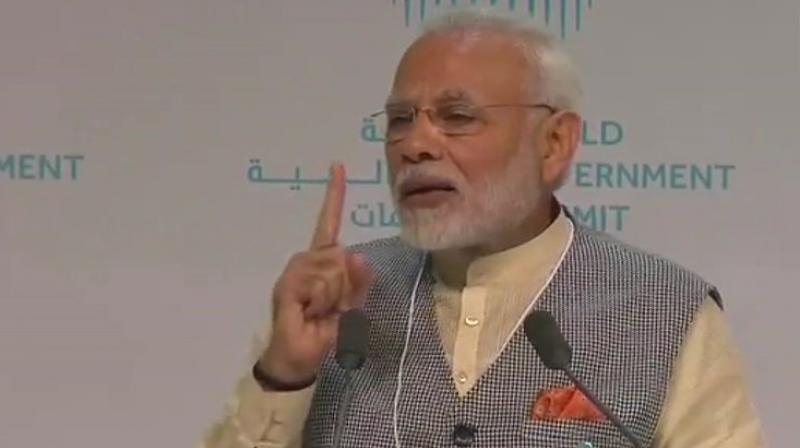Deft diplomacy needed, hugs just aren't enough

The hug-and-talk diplomacy on Prime Minister Narendra Modi’s three-day West Asia and Gulf tour from February 10 to 12 actually began in Amman, the capital of Jordan, from where his Royal Jordanian Army helicopter was escorted by Israeli warplanes to Ramallah, the Palestinian headquarters. This methodology was necessitated as Israel controls all access to the West Bank under Palestinian control. Government spokesmen of course gushed over its historic nature as indeed it was the first visit by any Indian Prime Minister to Ramallah. The visit was more to balance Mr Modi’s earlier standalone visit to Israel in July last year as well as the hosting of Israeli Prime Minister Benjamin Netanyahu in India last month with excessive exuberance, which included the lockdown of Ahmedabad for a street-level cultural extravaganza. India announced a $50 million aid package to the Palestinian Authority but dropped some crucial formulations, including a reference to East Jerusalem as the future capital of Palestine, a standard incantation in the past. Also, the need for a two-nation solution was omitted. Murmurs were heard that Mr Modi had set forth on West Asian peace-making, which many in the past have attempted and failed at, including some powerful US Presidents. More likely it was a “bucket-list” trip to observe a formality.
The situation in West Asia has mutated drastically since the Syrian civil war began half a decade ago. Syria’s President Bashar al-Assad, an Iranian ally, has survived, albeit with diminished territory. Iran is embedded in the region with bases in Syria and its close allies, the Hezbollah, bloodied and emboldened in Lebanon. An Israeli plane attacking Syrian targets was shot down by Syria on the eve of Mr Modi visit. Hamas, which controls Gaza, in defiance of Palestinian President Mahmoud Abbas, has restored its links to Iran after falling out in 2011 over its refusal to support Mr Assad. In fact, its leaders had shifted from Damascus to Qatar, which itself has fallen out with Saudis and the Emiratis. Meanwhile, US President Donald Trump ruffled Arab and Muslim feathers with his December 6decision to recognise Jerusalem as Israel’s capital and announcing the shifting of the US embassy there. Mr Modi’s amnesia now about Jerusalem as the joint capital of Israel and Palestine widens options as India had earlier voted at the UN to condemn the US move. But President Abbas is an isolated and increasingly marginalised figure surviving more on Israeli goodwill than Palestinian support.
The Prime Minister’s visit to the United Arab Emirates was pegged on two items — foundation-laying of a temple and attendance at a global governance summit. Mr Modi laid a wreath at the UAE’s martyrs’ memorial Wahat Al Karma, commissioned in 2015. Although among its 200-odd names are a few who died during past conflicts with Iran and during the liberation of Kuwait, the bulk relate to the UAE Operation Restoring Hope in Yemen since 2015. UAE troops are fighting in Yemen against Houthis, who are Iranian allies. The Iranian IRGC will note the gesture. India’s leaders are best advised to remain neutral in the raging wars within the Islamic world, as wise Indian leaders have done in the past. The allotment of land for a temple in Abu Dhabi is noteworthy but hardly epoch-making. Temples have existed in Dubai for decades. In 2001, when I was India’s ambassador to the UAE, late President Sheikh Zayed allotted a huge chunk of land for a cremation ground in Abu Dhabi. This was necessitated as Sharjah and Dubai were making it difficult to use their cremation grounds dating from before their independence in 1971. Within the grounds, the construction of a temple had been allowed and indeed planned. Then home minister L.K. Advani, when calling on late President Sheikh Zayed in mid-2001, had thanked him. Sheikh Zayed had replied that if Allah wanted all to be Muslims, that would have been so. Because it was not, the Nehyan ruling family recognised religious pluralism. History did not begin four years ago when NDA-2 came to power. It merely marches on in new hands, in India as well as in the UAE.
The stopover in Oman was necessary as Sultan Qaboos is aging and infirm and has no clear heir. Thus, chemistry with his successors is necessary. Often it is said that Oman sits facing India across the ocean with its back to the Gulf. It controls the cone of territory, north of UAE, overlooking the Straits of Hormuz. It also maintains excellent relations with Iran and all five other members of the Gulf Cooperation Council, despite the bitter quarrel of some with Qatar. Military and naval cooperation has existed in the past and will get a fillip now. Even in early 2000-01 the Dolphin project was proposed for piping gas through a sub-sea pipeline from the Omani coast to Gujarat. Today technology for such a venture exists. It could be Iranian or Qatari gas as the main gas field is shared by both.
That pipeline would bypass Pakistan, with its attendant security issues. But as Prime Minister Modi toured the extended western neighbourhood of India, the real challenge lurked in the nation’s immediate maritime domain. The Maldives has been slipping towards dictatorship and into the Chinese sphere of influence since 2012, when President Mohamed Nasheed was ousted in a bloodless coup. Matters reached a climax on February 1 when its Supreme Court ordered the release of detained senior political leaders. A state of emergency was imposed by the incumbent ruler and even some judges arrested, including the Chief Justice. Instead of intervening swiftly to restore order, India has dithered. China, on the other hand, has gone from general formulations about non-interference in the internal affairs of other nations to warning India. The window for power projection is fast slipping. Temples, new or old, in the UAE and Oman will not stall a predatory China. Deft diplomacy and military muscle in India’s immediate periphery may.

